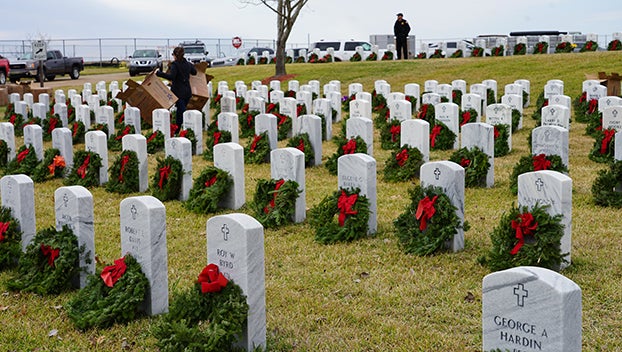After the flood: Flood fight involved more than protecting riverfront
Published 12:02 am Sunday, May 20, 2012
NATCHEZ — Even the closest river watchers can’t know everything that went into preparing for the flood fight last year.
“It was a lot bigger process than the average person knows about — that was a fact,” said Lance Moore, the warden at Concordia Parish Corrections.
Moore said he might have been wading in water if it wasn’t for the offenders who provided labor.
Jason Parsons, a four-year resident at the parish prison, said he’s from New Orleans, so he’s familiar with looming natural disasters.
“Where I live we’re always under the shade of a hurricane,” Parsons said.
So when he passed the screening process to build floodwalls on the riverfront and ride the levee searching for sand boils, he clicked into efficiency mode.
“We’ve gotta save our wet state,” Parsons said.
Plus, it was something different besides maintenance around the facility.
“It breaks up the monotony,” he said.
Parsons was on the carpentry crew that built a wooden flood retaining wall on the riverfront before the project was abandoned as crest predictions rose that would render the wooden wall useless.
“We busted out butts trying to get it up there,” Parsons said.
Shortly after that, the plan changed to protect riverfront property with individual walls or islands of Hesco bastion barriers.
Parsons said he believes the reason no inmates caused problems and often worked through their lunch breaks was because of a rare opportunity they had to help the community and because of the way the prison treats them.
“I’ve been to places where they treat you like stock or cows,” he said. “(At CPC), they treat you like human beings, as long as you act like a human being.”
Back at the prison, kitchen crews worked around the clock feeding workers as inmates speculated about the crest predictions.
Moore said the committee updated files on inmates every six hours and kept the phone lines open so families could reach the inmates.
The prison had an evacuation committee who planed for their 510 prisoners, which would be moved to three different Louisiana Department of Corrections facilities, Moore said.
Concordia Parish Sheriff Randy Maxwell said though protecting the riverfront was of paramount concern, much of the work during the flood went into preparing the parish in case the levees broke or were breached.
Maxwell said he sent deputies out knocking on doors to identify elderly people who didn’t have family in town to help them evacuate.
“You’d be surprised how many people you see like that,” Maxwell said.
Lessons learned from Hurricane Katrina came in handy.
Maxwell recalled evacuees coming to Concordia Parish from the New Orleans area in 2005 and the problems it caused.
“They’d have a pocket full of blue pills and a pocket full of red pills,” Maxwell said.
So the sheriff’s office made sure they knew where the elderly lived and what their specific handicap might have been. Local doctors and churches aided the efforts. If someone needed oxygen or a wheelchair, the deputies were aware of it if they needed to be evacuated.
In the case of an evacuation, those who needed to be moved would go to places like Monroe or Alexandria, Maxwell said.
And Maxwell said his office and the state police had plans to put contraflow into action at the Mississippi River Bridge, with both bridges heading toward Natchez.
Another hurdle to overcome was misinformation, much of it that spread through social networking.
Maxwell fielded many calls in which he confirmed or denied rumors.
“I heard levees broke you have six hours; there will be 14 feet of water in six hours,” Maxwell said.
None of it was true.
He was also in constant communication with other players in the flood flight, like Mayor Hyram Copeland, Levee Board President Reynold Minsky, officials form the Corps of Engineers and state officials.
“My phone was just melting I had so many calls,” Maxwell said.
Minsky said though the levees held up there were serious problems.
He was riding a levee north of Lake Providence, when a sand boil erupted approximately a quarter mile away from him.
“We had a bad blow out…it shot sand up about 12 feet in the air,” Minsky said.
A sand boil results when pressure from the river forces water under the levee, displacing soil and forming a hole.
The worst sand boil near the Miss-Lou was one north of Lake St. John. Maxwell agreed to that.
Looking back, Parsons said he gained a real sense of accomplishment helping during a crisis. And it was quite an experience, as well.
“I tell you what, I’ve never seen a river like that,” said Parsons, who got a view of the record flood closer up than probably any regular resident in the parish.
“I just couldn’t believe that sucker, how fast the river rose.”
Maxwell said the flood fight provided a rare opportunity for cooperation that showed how efficient local and state organizations can be when working toward a common goal.
“It’s a shining example of what you can do if everybody just does their job and don’t worry about who gets their name in the damn paper,” Maxwell said.
Minsky, who has been on the levee board for nearly 30 years and president of it since 1995, said May 2011 was the worst river fight he’s ever experienced.
“I’m so glad nothing happened again (this year), it’s not even real,” he said.
“I mean, last year this time I was in my neck in alligators.”






